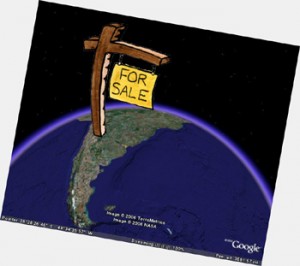Chosun Ilbo | 10 September 2008
Argentina lies on the other side of the world, with seasons completely opposite and the time difference exactly 12 hours from Korea. There is Korean land in that country, 20,894 hectares of pampas some 1,000 km northwest of the capital Buenos Aires. The Korean government bought the land in 1978 for US$2,115,000, but it has remained neglected for about 30 years. It looks desolate with just a few scrub trees standing here and there. But the Korean government has recently pushed for a project to develop the property into pasture and forest.
Neglected for 30 years
The land was purchased by the Korean Overseas Development Corporation (the predecessor of the Korea International Cooperation Agency under the authority of the Ministry of Foreign Affairs and Trade) during the Park Chung-hee administration. At the time the KODC was in charge of emigration affairs, including recruiting nurses and miners to send to European nations. It bought the land on Park's instructions to send some 300 farmers to South America, envisioning building a Korean village. The project ended in failure. Immediately after it was bought, dozens of farmers in the first batch of emigrants went to settle the land to cultivate millet, cotton and beans on a trial basis. The crops were unsuccessful.There were several reasons for the failure. In summer it was sizzling hot with temperatures soaring over 40 degrees Celsius. In winter there were severe temperature swings and many mornings of frost. The annual average precipitation was a mere 500 to 600 mm. The biggest problem was that the land contained salt -- the name of a small river flowing through the area is called "Salado," meaning salty. Eventually the first arrivals gave up and scattered into various Argentine cities. The Korean government's plan to recruit a second batch of emigrants miscarried. Since then the land has remained neglected. Far from profiting, the government has been sending US$12,000 to Argentina every year for management costs and taxes.
Developing pasture and forest
There have been some signs in recent days that this neglected land may be brought back to life. The Foreign Ministry is consulting with the agriculture and finance ministries on handing over the land, currently owned by the KOICA, to the Korea Rural Community & Agriculture Corporation, an agency specializing in land reclamation and development under the Ministry of Agriculture and Forestry. The plan aims to put the land in the care of a specialized agency to develop it into a useful property. The Agriculture and Forestry Ministry and the KRCAC are giving top priority to developing it into pasture and forest. As it is located in a subtropical zone between tropical and temperate zones, it will be possible to develop it into woodland or pasture to raise livestock once a source of water supply is secured, the Korean government believes.
Some have proposed securing carbon dioxide emission rights by planting trees, which could then be sold to enterprises that emit pollutants. A few years ago, a quick-eyed foreign enterprise proposed to the Korean government that it be awarded a lease to plant trees and begin a carbon emission rights business. The Foreign Ministry once even planned to build an eco-forest to dedicate it as a "forest of friendship" between Korea and Argentina.
A senior official with the Agriculture and Forestry Ministry said, "Just as the financing and semiconductor sectors have advanced into overseas markets, so we plan to build farmland in Argentina as a model of success of the agricultural sector’s advance overseas."












